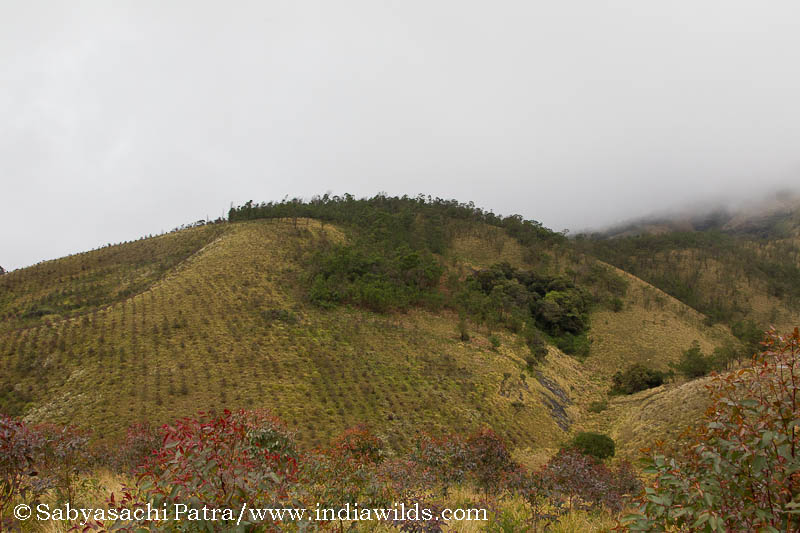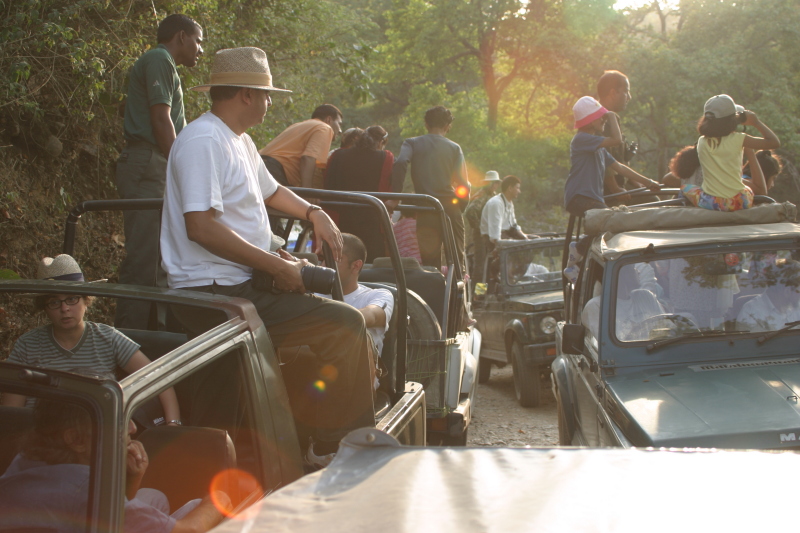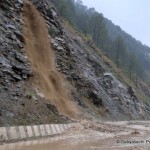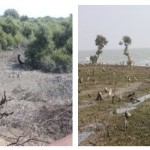IndiaWilds Newsletter Vol. 9 Issue V
Unleashing a Genie – GMO Mustard
India on the cusp of a self-destructive plunge into toxic world of GM Foods & GM Mustard

IndiaWilds May 2017
India had till date not approved GM food crops. Its earlier attempt at introducing GM food crop was the failed attempt by the Manmohan Singh led UPA Government, which withdrew the GM Brinjal crop due to considerable opposition from public at large. However, now times have changed and public opinion and public interest doesn’t appear to matter much to this Government, as GM Mustard will soon be approved for cultivation in India.
Modi Government after assuming charge in 2014, started systematically dismantling the previous era policies, departments and way of working. Or atleast that is what we were told and made to believe. However, the more things change, the more things remain the same.
In 2015, Modi Government announced that the Planning Commission, which had been running since 1950, would be scrapped. It was said that the Planning Commission was a white elephant and did little to contribute to India’s Growth during the previous 65 years. So Planning Commission was scrapped and Niti Aayog was created. Looks like it is old wine in new bottle, except that this old wine tastes stale and even more bitter.
The powers to be in the Niti Aayog appear to have been completely bowled over by the MNCs like Monsanto and the GMO lobby. It had been consistently pushing for the introduction of GM Crops in India, in the guise of improving the food productivity.
It is often argued that GMO crops are more high tech and will solve the future needs of India’s huge population. So GM crops are promoted as a magic wand, which will miraculously cure India’s food problem and remove poverty. By riding of the poverty and productivity bandwagon, the GMO lobby is pushing their technology to make money despite massive negative impact on people, health, and environment. And not only that, this will lead to farmers losing their independence, the very basis of Swaraj that Indians pushed for and threw the British Government from India in 1947. It is another matter that today nationalism has only been reduced to cow protection.

Mustard
It was always expected that the GEAC (Genetic Engineering Appraisal Committee) was a rubber stamp of the Niti Aayog and will do as per its diktats. However, the manner in which the GEAC has turned a blind eye to the real life disaster of Bt Cotton introduction in India and pushing BM Mustard in an opaque manner is extremely disturbing.
Failure of GM Crops in India:
India in the 1990s had allowed the introduction of the Bt Cotton. This was allowed against stiff opposition as some of the well meaning individuals in the Government at that time seriously thought that introduction of Bt Cotton will result in significant improvement in the productivity of the cotton as the Bt Cotton has been genetically modified to supposedly fight the pests.
There was lot of media hype created during that time that the Bt Cotton of Monsanto would help fight the Cotton pests like bollworm without any need for pesticide sprays. The lure of fighting the pest menace, higher productivity and higher profits made many farmers reluctantly agree to buying seeds from Monsanto, even though it meant losing their independence. Farmers in India are known to harvest the seeds from their own crop. Monsanto forced them to continue buying seeds every year.
The Government officials thought the Bt Cotton would result in India becoming self-sufficient in cotton production, which will result in enough good cotton for the spinning mills in our country. Bt Cotton was believed to be the panacea of all evils afflicting the cotton farming as well as the dependent textile sector in India.
Indian Textiles was supposed to march ahead of other countries due to abundance of high quality cotton crops at lower prices grown by Indian farmers using Bt Cotton seeds. So the Government officials also agreed to open up to the MNC despite gross misgivings about the efficacy of Monsanto’s Bt cotton and the impact of this crop on the biodiversity. The marketing machinery of Monsanto used all their tricks and was successful in India opening up to Bt Cotton.
After more than two decades the results are glaringly evident that Bt Cotton has been a failure. There have been many protests in India in the Bt Cotton growing states against Monsanto due to the failure of Bt cotton. Scientifically it has been proved that the genes from the GM crops escape into the wild and hybridisation of the native species occurs, which is disastrous for the environment.
Nature has given each species the ability to adapt to conditions. The few ethical scientists who were not influenced by the marketing largesse of the GMO lobby had raised the specter of pests developing resistance to the Bt gene. And that is precisely what has happened now.
Monsanto has also admitted:
that in Amreli, Bhavnagar, Junagarh and Rajkot districts of Gujarat, the pink bollworm pests have developed resistance to the BT Cotton. So now Monsanto wants the farmers to shift to its next generation of seeds for which the insects haven’t developed resistance and also it wants the farmers to plant non-BT Crop as refuges around the BT Crop so that the so called refuges would attract the insects. This will also reduce the acreage under cultivation for cotton.
Traditionally farmers used to plant different crops side by side and that used to help attract the birds and other species that feed on the pests. It is ironic that after junking traditional farming practices in the name of high technology the MNC is finally advising the farmers to use traditional practices.
Recently, the then Textiles Secretary T.S.R. Subramanian has admitted that it was a mistake agreeing to introducing Bt Cotton in India. In an article he writes “Most of the countries that have higher cotton yields than India do not grow GM Cotton. The package of promises sold to us did not reveal all of this. If I had an inkling of the future at that time, Bt Cotton would not have been introduced in India” (The Hindu, May 25, 2017).
Rarely in India the bureaucrats regret their mistakes, especially in public. Mr TSR Subramanian is a former Cabinet Secretary as well, and he is no supporter of environment and wildlife so he can’t be accused of bias against Monsanto. His previous recommendation on modifying India’s wildlife and forest related laws to help industries was widely criticised (https://www.indiawilds.com/diary/indiawilds-newsletter-vol-6-issue-xii/ ). Nevertheless that report had cautioned MoEF&CC about the limitations of Science hence was against GM Crops. So when such a man regrets his decision to help allow Bt cotton introduction in India, it should come as a warning call for any further experiments in GM crops in India.
Unfortunately, the Modi Government despite the promise made in the BJP manifesto of not allowing GM crops, has compromised and is selling India to the GMO lobby. The GM Lobby has suddenly found the Modi Government to be more pliable to their cause than the Manmohan Singh Government and ready to compromise and introduce this risky and toxic technology.
Developed countries against GM Crops:
The European Union has clearly said no to GM crops. Russia, which is no backward country as far as science and technology is concerned, has clearly put its foot down and disallowed GM Crops. China, the world’s most populous country, which should have been more concerned about improvements in productivity, is wary of the future problems that this new technology will unleash and have said no to GM Crops. Except for Australia, Canada and USA, none of the other top 20 most developed countries allow GM crops.
Health Risks:
The GM crops have resulted in severe health hazards in US and Canada. Unfortunately, these days the MNC health firms are eagerly waiting for new diseases and hence GM crops have come as a boon to them. A study titled Health Risks of Genetically Modified foods has concluded “The results of most studies with GM foods indicate that they may cause some common toxic effects such as hepatic, pancreatic, renal, or reproductive effects and may alter the hematological, biochemical, and immunologic parameters. However, many years of research with animals and clinical trials are required for this assessment. The use of recombinant GH or its expression in animals should be re-examined since it has been shown that it increases IGF-1 which may promote cancer.” (Health Risks of Genetically Modified Foods, Dona A. et al. 2008, Critical Reviews in Food Science and Nutrition,
GM Foods to Impact Ayurveda:
Unlike India, countries like US, Canada, Australia has virtually exterminated or sidelined their native people and hence they hardly have any knowledge of native medicines like we have Ayurveda in India. For Ayurveda medicines, one needs to use only native breeds of plants, vegetables, fruits and other plant products. The GEAC, Niti Aayog, GMO lobby may not care, however, the Modi Government has to realise by introducing GM food crops they are striking at the core of India’s health, food, culture as well as wellbeing. You can’t promote Yoga when the food you eat is contaminated. Interestingly, the Modi Government has an Ayush ministry however promoting GM food crops shows that the ministry is perhaps more for Show. Allowing GM food crops like GM Mustard goes against the general philosophy of wellness that the present Government is promoting. Will the Government walk the talk?
GM Mustard is not high yielding:
The GMO lobby wants to peddle the falsehood that the GM Mustard is very high yielding. Unfortunately it is farthest from the truth. DMH-11, the GM Mustard which is being introduced in India is not the one with highest productivity. There are four other varieties which have higher yields than the DMH-11, which is the GM Mustard approved for introduction in India. DMH-4, which is a traditional variety has even a 14.7% higher yield than DMH-11, the approved GM mustard variety. So clearly, the scientists, GEAC and Niti Aayog officials have a lot of explaining to do. If ever there was a worthy cause of a CBI investigation, then this is it.
The DMH-11 mustard variety is a herbicide tolerant variety. In India, farmers use mustard along with other crops like wheat. So when DMH-11 is grown with wheat, it will kill the wheat crops. So this is completely against the Indian farming interest.
Import Duties:
Indian farmers never face any challenges in producing the mustard crop. The main challenge they face is getting the right price. Most of the times the Government procurement is lopsided and the farmers don’t even get the MSP (Minimum Support Price). India imports a huge amount of edible oil. Roughly 60% of its oil requirements is imported, because the import duties have been virtually negligible. Why can’t the Government of India protect our farming interests? Our politicians have their favourite quotes that India is a nation of farmers. However, the farmers are just a piece in this chess game of vested interests where the farmers are sacrificed for promoting the interests of corporates, politicians and some bureaucrats.
If the Modi Government were sincere about improving the lot of farmers, then it should ensure that the farmers cultivating mustard in the 65 lakhs hectares get the benefit of Minimum Support Price (MSP).
Crop to Wild Hybridisation & Impact on entire ecosystem:
One major challenge of introducing GM mustard is the danger of crop to wild hybridisation. The GM genes will escape into the wild and create hybrids in the wild plants. There have been many well documented cases in US of GM creeping bentgrass (A. stolonifera) hybridising with the (A. gigantea) (Watrud et. al., 2004) and the escape of GM genes into the wild has been proved in Indian context as well. (The Potential for Crop to Wild hybridization in egg plant in Southern India, Davidar et al. 2015, American Journal of Botany). This crop to wild hybridisation will impact the genetic diversity. Our science is at a nascent stage and the impact of many plants and other organisms has not been studied in detail. There is a complex chain of ecological relations which bind different organisms together and when one part is disturbed, it sends shock waves. We may not be able to immediately observe or understand, however, the impact is likely to be felt in completely different areas.
When bees will suck nectar from the flowers of the GM mustards, it will also come to our food chain through honey. The bee-eaters who predate on the bees will also bear the brunt of the GM crop. The birds of prey like eagles or lesser carnivores who predate on the bee-eaters will also get impacted. And it will continue to move through the food chain and can impact each species in a different manner.

Bee on Mustard plant Courtesy – online media
George Schaller while writing on the chapter Rainforests had this to say, which is also applicable to other ecosystems:
“we can plant trees but cannot re-create the original forest. Ecological processes are so complicated that planted forests are only superficial replicas…. We still know too little to manipulate forests and predict the consequences.… An intriguing aspect of rainforest life is its extraordinary mutualism, a dependence of organism upon each other. For instance, each of the many fig species has its own wasp pollinators. A rainforest is remarkably complex, yet its stability is tenuous. The extinction of a pollinator or seed disperser may cause the death of a plant species and with it many other species, especially invertebrates, which depend on it. Such responses are subtle and perhaps long delayed. How many key species can a rainforest lose before order becomes chaos, before the community collapses in an avalanche of extinctions?”
No real trials to study impact:
Unlike other oils, mustard oil is also used raw in some of our cooking preparations. There have been no animal and human trials and the GEAC has pushed for introduction of the CM Mustard. The GMO lobby and the scientist and persons hand-in-glove with the GMO lobby will always talk good about their product. We are at times when a majority of the people feel earning money by compromising on ethics is fine. So should we be shocked that the GMO lobby and officials hand-in-glove with the GMO lobby are pushing for introduction of the GM Mustard? So it may not come as a shock if people come to know that the scientist vehemently pushing for the introduction of GM Mustard was sent to jail in Novembver 2014 for plagiarising the work of his colleague (http://www.ndtv.com/india-news/ex-delhi-university-vice-chancellor-deepak-pental-sent-to-tihar-jail-on-plagiarism-complaint-703842 ). The shocking thing is actually how the Government has blatantly agreed to allow the country’s future to be risked by accepting the recommendations of an ethically challenged scientist.
The GMO lobby will continue to push its case because Monsanto’s Bt cotton seeds sale is to the tune of $100 million dollars a year (roughly 650 crore rupees a year). So in this high stakes game, ethics easily becomes a casualty. If GM Mustard is allowed to be introduced in India, it will change the environment, biodiversity, health of people, Ayurveda as well as our culture forever. Can Modi Government, which prides itself about Swadeshi, rise above this and protect India’s interests by banning GM Mustard? If not, the future appears increasingly bleak.
The Forest Department: Conserving nature starts at home
By Jean-Philippe Puyravaud, Sigur Nature Trust
Even though biodiversity conservation is also needed outside protected areas, most of it happens inside protected areas. Since protected areas are under the responsibility of the Forest Department, we conservationists / photographers / wildlife lovers, have to deal at one point or another with this administration.
The history of the Forest Department is old and complex. Created during the British occupation, it originally helped to extract resources from the subcontinent and “protect” the forests against villagers who saw their traditional rights denied. Since the Indian Forest Service continued to safeguard the same areas as the occupants, there was a management continuity from the British rule that helped promote the idea that the Forest Department is functioning on the principle of colonialism.
The second problem faced by the Forest Department was its narrow foundation in forestry. Forestry tended to consider tree monocultures as “forests” and grasslands as “degraded ecosystems”. According to this logic, any area covered with trees is good, anything else is bad and anyone thinking differently could not be taken seriously. This is how “restoration” programs resulted in ecological disasters, where grasslands for example, were covered with invasive exotic tree species. The disconnection between society and the Forest Department attracted and still attracts criticism. In some parts of India, for example, tribal groups are opposed to conservation on the basis of a condemnation of “colonialism”. Now and then, scientists also complain of difficulties in obtaining research permits. There has been evolution however, the Forest Department personnel is now better trained in ecology, conservation or social sciences. There are also efforts made in involving different stakeholders in the management of forests.

Exotic eucalyptus plantation which depletes ground water is planted in the Shola forests of western ghats, India
On the other side of the Himalayas, another country comparable in human population, China, offers insights on a different system where resources were accessible to all for the sake of egalitarianism and later for the sake of development. China has lost most of its ecosystems and is now actively promoting the restoration of whatever natural heritage remains – because it needs them. It may be that without the Forest Department tenaciously controlling a significant part of the territory, India would be in the same situation as China. Moreover, if one considers that ecosystems and biodiversity are particularly useful for the poorest segment of the population and represents a capital in terms of ecological services for now and the future, certainly, the Forest Department has some utility.
So there are elements of schizophrenia or mixed feelings regarding the Forest Department. On the one side, the Forest Department is useful, not to say indispensable, on the other side, it has its own peculiar culture that we have to deal with. One could wait for this Administration to modernize or one could attempt to induce some changes in favour of better management of protected areas. We must underline some difficulties caused by society itself in order to act effectively.
The Forest Department is constantly under the pressure of VIP’s to dance to their tune. Officials are at the beck and call of politicians: when a Forest Minister wants an official to come to his office, there is no effort whatsoever to enquire about the schedule of the official himself otherwise it would be perceived as a loss of face. The bosses give orders and it is up to the lower ranks to obey. Consequently, officials cannot organize their time effectively or even prioritize issues to be addressed. All is done in a haphazard manner, scrambling all attempts at organization and probably costing millions to the country in useless trips. Next time you want to take an appointment with a DFO or a Field Director, you should know that the appointment system does not work at all at the highest level of the hierarchy: how can you expect it to work with your officer?

Forest Department is constantly under pressure to tend to VIP tourists
Worse, officers must attempt to prevent protected areas to be used as private parks by politicians and their families. It is common practice to descend on forest lodges and occupy it at the expense of the persons who had made reservations following the proper channel. It also happens that the same people demand to have access to core areas, at night, in their four wheel drive, to experience the thrill of a night safari in the most illegal manner. Lastly, it is not the secret that for such crooked hosts, everything must be free, actively promoting the practice of corruption. When the lowest ranked personnel must generously attend to the food and drinks of a party, they do intend to recover their expenses on other illegal visitors.
The field personnel is overstretched by a variety of issues, the worst being maybe encroachment or illegal structures, where again, the hand of politicians can often be seen. When say, an illegal resort is built, the field personnel does not have sufficient authority to address the problem. They can be threatened or mocked or purchased. Even though we have a centralized system to pay taxes, there is no centralized system to book offenders and create a permanent record in a protected database. If a ranger wants to punish a tourist who has stopped his car in a national park to observe elephants, the offender will call an influential relative who will find a way to cancel the punishment. Basically, the Forest Department personnel is left without the support of their administration unless their superior has the power or the guts to go against a generalized practice of coercion, at the risk of his/her career.
The field personnel is also exposed to criminals such as poachers and some live in constant threat. I have met rangers with bullet wounds who were very dedicated to their work in spite of earning a small salary, getting little acknowledgement and minimum help when it came to pay the hospital bills. The rangers and guards who put their lives in the line of fire to protect, deserve our admiration and even better, our support.
Even obtaining research permits can be difficult. The officers supervising files may not have the training to decide whether a study is needed or not. In order to get help, they request the opinion of academicians. But here, unfortunately again, there is a lot of murky activities. The experts, forgetting their scientific ethics, often are negative about their competitor’s proposals, and reutilize them with cosmetic change to get clearance of the Forest Department through their acknowledged eminence.
In conclusion, there is a lot to say about the Forest Department, but major difficulties are social evils. It is therefore our role to be involved in a positive manner, by imposing better standards on society, bringing solutions, offering training, and participating instead of just sitting on the other side of the fence, waiting. Each time we correct something wrong, chose a good representative, demand transparency in our cities, we may promote conservation in a faraway land.
Conservation News:
Anil Madhav Dave: Union Minister for MoEF&CC passes away
Shri Anil Madhav Dave, while serving in the capacity of Union Minister for Environment, Forests & Climate Change passed away on 18th May 2017. Shri Dave was Minister of State with Independent Charge of MoEF&CC. He was not well since January and was clearing the files at his residence. He had complained of chest pain, uneasiness and breathlessness and was rushed to AIIMS (All India Institute of Medical Sciences) but his condition deteriorated and he soon passed away.
Shri Dave was a member of Rajya Sabha since 2009 and was sworn in as Minister in July 2016. He had a soft corner for Narmada river, writer and he was also an amateur pilot.
He was well-known for his work on river Narmada through an organisation ‘Narmada Samagra’ founded by him, which works on conservation of Narmada and its catchment area through various activities and events.
His 10 months as minister for MoEF&CC would be known for projects, which has significantly negative impact on the wilderness, wildlife and environment. He had fastened the approval of the disastrous Ken-Betwa river linking project where a large chunk of Panna Tiger Reserve would be submerged. He had also fast tracked the GM Mustard project.
May his soul rest in peace.
Dr. Harsh Vardhan assumes charge of MoEF&CC
Dr. Harsh Vardhan, Minister for Science and Technology and Minister for Environment, Forest and Climate Change, assumed charge at the IP Bhavan on 23rd May 2017. He had to take over the charge of MoEF&CC due to the sudden and untimely demise of former Minister of State (Independent Charge) Shri Anil Madhav Dave.
Dr. Harsh Vardhan commenced his visit to the office by first planting a sapling in the memory of Late Shri Anil Madhav Dave in the premises of IP Bhavan. He said that he felt humbled at taking over charge of the Ministry of Environment, Forest and Climate Change and recalled the contribution of Late Shri Dave as a great champion of river conservation and environment. He pointed out that Shri Dave’s love for children was evident in his belief to restore our environment for our children. “Dave ji did a great deal of work to protect our rivers, forests, ecosystem with the passion and the dedication of a true environmentalist”, he said. Dr. Harsh Vardhan recalled the words of Shri Anil Madhav Dave, who used to say, ‘If I can, so can we’. The Minister emphasised that the Ministry will always keep in mind the last wish of Late Shri Dave of environmental protection by planting, protecting and nurturing trees and of cleaning rivers and ponds.
Dr. Harsh Vardhan reviewed the key areas of concern and priority with the Secretary and other senior officers of the Ministry. The progress of work in the last 3 years of this government and the key initiatives taken were discussed. He acknowledged that there are many immediate and complex issues of environment, forest and climate change, which will need collective and concerted efforts. He emphasized the mission of the government under the leadership of Prime Minister, Shri Narendra Modi, for integrating environmental concerns into development policies and programmes and balancing the two for India’s sustained growth and progress. For this, it was important for the Ministry to quickly adopt the latest technologies, re-engineer clearance processes and develop policy initiatives to further enhance transparency, accountability and timely delivery.
The Minister focused on policies and programmes for climate change adaptation and mitigation; biodiversity protection; pollution prevention and cleaner production; promoting circular economy for waste management through the concept of 4Rs (Reduce, Recover, Reuse And Recycle); eco-tourism; afforestation on degraded lands and disbursal of CAMPA funds to the states. In particular, he emphasised that “Pollution, both of air and water, is a matter of concern for the whole country, in general, and especially Delhi and NCR, and needs to be addressed on priority by the Ministry.” He also underlined that Climate Change and the commitments of India in the Paris agreement are another important challenge. He exhorted all the officers to continue to strive hard and meet these and other similar challenges in the coming years. “Involvement of the people is crucial, and for protection and conservation of environment people’s participation has to be increased”, Dr Harsh Vardhan added.
Sundarbans reeling under threats from Industries:
IUCN report has highlighted the threats faced by Sundarbans from shipping and industrial activities.
The Sundarbans which is spread over India and Bangladesh is a World Heritage Site and recently concerns were raised about the impact of population growth, shipping and industrial activities. In 2016, there was considerable outrage over the setting up of a 1320 MW Maitree Super Thermal Power Plant in Bangaldesh and an IUCN reactive monitoring mission had visited Bangladesh in March 22-28, 2016. This was undertaken following the World Heritage Committee Decision 39 COM 7B.8.
The IUCN mission had found that there is a high likelihood that the Outstanding Universal Value (OUV) of Sundarbans as a World Heritage Property would be impacted. The power plant is located at 65kms from the closest boundary and there would be impact from ash deposited through air, pollution by waste water including ash in waste water as well as other cumulative impact from related industrial development would irreversibly impact Sundarbans.
The World Heritage Committee reports released yesterday include IUCN’s advice on necessary measures to tackle threats affecting the world’s iconic natural areas.
The World Heritage Committee has monitored 55 natural World Heritage Sites in the past year which includes Sundarbans.
“Natural World Heritage sites facing threats include Doñana National Park in Spain, a crucial wetland for migratory bird species which is threatened by unsustainable use of water for agriculture; and the Sundarbans in Bangladesh home of the world’s largest population of tigers, together with India’s Sundarban National Park, which is exposed to a number of threats including a coal-fired power plant project, increased shipping, and reduced inflow of freshwater,” the report said.
Though the natural World Heritage sites get international recognition and it gets coverage in media, the sites continue to face serious threats. The increase in number of industries, threats due to armed conflicts as well as the overarching impact of Climate Change continues to haunt these World Heritage Sites.
At present Sundarbans is not classified in the List of World Heritage in Danger. However, if the IUCN recommendations are not followed, which looks likely, then Sundarbans would be listed in the in danger list.
Sundarbans which is spread over India and Bangladesh covering roughly 10,000 sq kilometers, is famous for its tigers, the name Sundarbans is because of “Sundari” a type of mangrove species. The various mangrove species are known to do about 3-5 times more carbon sequestration than other trees. So in this era of climate change, its presence is extremely valuable.
Illegal road-widening in Male Mahadeshwara sanctuary
A 4.5 km stretch of road connecting Hannur, Ajjipura and Ramapura passing through Hanur Buffer Zone and Male Mahadeshwara Wildlife Sanctuary is illegally being widened.
No roads can be widened without prior permission from NBWL (National Board of Wildlife). For each road widening project, sanction is only supposed to be given after considering the impact on the wildlife and deciding on the mitigation measures. It is another matter that NBWL has been granting road widening permissions for almost all the tiger reserves and wildlife sanctuaries. However, the PWD has just gone ahead with blatant disregard for the law.
The road from Hanur to Ajjipura is already having its negative impact on the wildlife and two spotted deers have died due to road accidents in this year. Road widening results in wildlife getting less time to crossover to safety. Apart from the large charismatic wildlife, many smaller species as well as herpetofauna find it very difficult to cross wide roads.
Indo-Nepal Joint Patrolling to stop Wildlife Poaching:
India and Nepal have decided to undertake joint patrolling in the National Parks and Sanctuaries bordering the two countries to effectively deal with wildlife poaching. Poachers generally move on to the other side of the border after committing a wildlife crime so that it becomes difficult for the forest department to pursue them. The joint patrolling team will now find out the hiding places of these poachers to stop this loophole.
The Conservators and Directors of the Protected Areas along the border of both the countries recently attended a two-day meeting at Valmiki Tiger Reserve and decided on the joint patrolling. The Indian side was led by the field director of Valmiki Tiger Reserve, Shri Chandra Shekhar and the Nepali side was led by the Chief Conservation Officer of Chitwan National Park, Shri Ram Chandra Kandel.
With the Indian and Nepal forest officers agreeing to share information with each other and undertake field monitoring and joint patrolling as well as increase the staff strength in the parks, it is hoped that the incidences of wildlife poaching will reduce and the wildlife in the parks bordering the two countries will thrive.
Equipment Discussions:
DJI Spark Quadcopter for Selfie Generation
DJI has introduced the Spark Quadcopter which weighs a tiny 300gms and can take off and land on your palm. This quadcopter is of the size 5.6” x 5.6”x2.2”. The DJI Spark Quadcopter has a camera which is stabilised by a two axis gimbal. The Spark can record 12 MP still photos and Full HD (1080 @ 30p) videos. Unfortunately, the videos can only be recorded at 24Mbps data rate. So the quality will only be like the camera phones and not much better.

DJI Spark
The camera in the DJI Spark can has a 25mm equivalent focal length without any distortion. 5 elements arranged in a single group form the lens of this camera. There is a 1/2.3” sensor in the camera.
The photos and videos are recorded to a MicroSDHC/SDXC card upto max 64GB. The Videos are recorded in MPEG-4 AVC/H.264) format. The DJI Spark can fly upto 16 minutes.

DJI Spark
The DJI Spark has gesture based controls. So it can take take off and land on your palm, take your selfie, hover around you etc. If you want to fly it away from you and shoot videos at a distance then you need to use a controller.
The DJI Spark can detect obstacles and move around those. There are various modes which can be used.
ActiveTrack Subject tracking: In this mode the user needs to tell the DJI Spark what to track. It is programmed to detect commonly available subjects like people, vehicles, bikers and DJI claims that even animals can be tracked. So that would make it very interesting. In the ActiveTrack mode if the user selects profile, then the subject is tracked from a fixed perspective. In the Trace mode, the Spark can circle around the subject or track from front of behind the subject.
TapFly: Keeping with the already tapping on the phone habit of people, DJI has introduced TapFly mode where each tap on the phone is converted into a touch heading. If you want to change direction, climb or descend etc you can tap and give the directions. In TapFly there are also two modes. In the Coordinate mode you can tap on any part of the screen and the Spark quadcopter will fly to that direction while maintaining altitude. In the Direction mode the quadcopter will keep flying in the direction one taps the screen.
Sport Mode: In the sport mode the DJI Spark quadcopter can fly at a maximum of 50kmph. It is aimed at individuals who want to get into drone racing.
Flight Autonomy mode: The DJI Spark quadcopter has a FlightAutonomy feature which uses the main camera along with a VPS (Vision Positioning System), GPS, a high-precision IMU and a 24-core controller to ensure that it can accurately hover at any point upto 98 feet away using VPS assistance. It is able to sense obstacles from 15 feet away.
Return to Home: There is a return to home mode in the Spark quadcopter. If GPS is available the Spark will return on its own to the point where it took off. If in the meanwhile the battery gets very low or if for some reason the signal from the controller is lost or if the RTH (Return to Home) button is engaged, then the Spark will return home while avoiding obstacles.
Security: DJI has also included the GEO system which will warn the user about the quadcopter approaching airports and other areas of security.
Dual band Frequency operation: The remote controller and WiFi of DJI Spark works on 2.4 GHz and 5.8 GHz. So it can shift to less used frequency.
Due to the low data rates of 24Mbps this quadcopter is not meant for filmmakers. It will more likely appeal to the enthusiasts and selfie generation. The small size and ease of use is likely to appeal to a lot of people.
Price: The DJI Spark quadcopter is priced at 499 US dollars. With controller, charging hub and two batteries it is priced at $699 US dollars.
Preorder from B&H: https://www.bhphotovideo.com/c/buy/DJI_Spark_quadcopter/Ntt/DJI%2BSpark%2Bquadcopter/N/0/kw/search/BI/19990/KBID/13252/DFF/d10-v1-t12
Sennheiser Action Mic for GoPro® HERO4 Cameras
Sennheiser has added an interesting microphone for GoPro cameras. Everyone knows that the audio of our GoPro Hero 4 cameras are really rubbish. Looking at the ubiquity of the GoPro cameras, Sennheiser has created MKE 2 elements Action Mic for the GoPro Hero 4 cameras.
The MKE 2 elements Action Mic is tiny and weighs 45 gms and comes with a windshield.
One can just connect the MKE 2 elements Action Mic with the Sennheiser custom-made BacPac Backdoor to the GoPro and start recording.

Sennheiser Action Mic
Interestingly, the MKE 2 elements Action Mic connects seamlessly to the GoPro original housing, so one can have a complete and waterproof solution at your hands. However, recording under water is not possible. The MKE 2 elements Action Mic can cope with upto 1 bar of pressure and when you surface with the GoPro, the microphone can record sounds above water.
Dimensions: Case incl. Windstopper approx. 125 x 70 x 60 mm/ Windstopper 62mm diameter
Frequency response: 20 Hz to 20 KHz
Weight: 45g
Price: $199.95 US Dollars
Litepanels Launches Astra 6X LED lights
Litepanels has announced an interesting update to its Astra line of LED lights by launching introducing the Astra 6X Daylight LED Panel and the Astra 6X bicolour LED panel.
The Astra 6X LED panel offers six times the brightness as the original Daylight 1×1.

Litepanels Astra 6X daylight LED
The LED panel is of the same 1×1 form factor and comes in either daylight or variable colour balance depending upon the model, 0-100% dimming with negligible color shift and a universal (100-240 VAC) adapter. Separate VMount and Gold Mount battery plates are available so that one can use 13-24 VDC batteries.
Litepanels has said that there has been a massive technical advance in lighting technology and it is using tightly-binned LEDs as well as fine-tuned the LED bulb optics so that the TIR (Total Internal Reflection) is optimsed. The higher intensity of the lights result in the light reaching a longer distance as well as wider area. It boasts of 95 CRI and a 46 degree beam angle.
Litepanels 6X bicolour LED panels light intensity at 15 feet away is 735 lux, 1653 lux at 10 feet away and 6612 lux at 5 feet.
The Litepanels Astra 6X LED daylight panel has a colour temperature of 5600K and the bicolour panel has colour temperature which can be varied from 3200K to 5600K.
The Litepanels Astra 6X is flicker free at any frame rate. So even if one is shooting super slow motion or varying the shutter angle then there wont be any flicker.
The Litepanels Astra 6X has an aluminium I-beam construction which will result in a durable product and help in good thermal management. The exhaust vents angle downwards so that the air flows away from the lighting fixture. This will also help in preventing the entry of any foreign material with the airflow.
The Litepanels Astra 6X comes with 3-pin XLR power connector which is an industry standard.
Dimensions and Weight:
The Litepanels Astra 6x Daylight is 17.7 inch x 16.3 inchx 5.3 inch and weighs 3.2 kgs.
Price: The Litepanels Astra 6X daylight LED panel is priced at $1235 US Dollars.
The Litepanels Astra 6X bicolour LED panel is priced at $1425 US Dollars.
The DMX module is priced at $270 US dollars
The Litepanels Astra 6X can be preordered at this link:
Natural History
COUNTRY NOTEBOOK: M. Krishnan: ‘The Green Bee-Eater‘ By Saktipada Panigrahi
https://www.indiawilds.com/forums/showthread.php?8852-Country-notebook-m-krishnan&p=83256#post83256
Nasal salt secretion of Oriental Pratincole
https://www.indiawilds.com/forums/showthread.php?18280-Nasal-salt-secretion-of-Oriental-Pratincole
Wildlife Photography
Wolf in Tippeshwar by Subhash Shrivastava
https://www.indiawilds.com/forums/showthread.php?18220-Indian-Wolf-in-Tipeshwar-WLS
Prince of Bandipur by Jerin Dinesh
https://www.indiawilds.com/forums/showthread.php?18225-RIP-T-222-(Prince-of-Bandipur)
Indian Wild Boar from Corbett by Debasis Bose
https://www.indiawilds.com/forums/showthread.php?18246-Indian-Wild-Boar
Blue-tailed Bee-eater by Sandipan Ghosh
https://www.indiawilds.com/forums/showthread.php?18235-Blue-tailed-Bee-eater
Grandala by Abhishek Jamalabad
https://www.indiawilds.com/forums/showthread.php?18221-Grandala
Mooted Wood Owl by Uday Kiran
https://www.indiawilds.com/forums/showthread.php?18227-Mottled-Wood-Owl
Spotted Owl by Vipin Sharma
https://www.indiawilds.com/forums/showthread.php?18219-Spotted-Owl-BTR-diary-Mar-17
Lotens Sunbird from Masinagudi by Shymala
https://www.indiawilds.com/forums/showthread.php?18243-Lotens-Sunbird
Euantissa pulchara by Sagar Khunte
https://www.indiawilds.com/forums/showthread.php?18239-Euantissa-pulchara
Lynx Spider by Prajwal Ullal
https://www.indiawilds.com/forums/showthread.php?18222-Portrait-of-a-strange-looking-Lynx-beauty
I look forward to your inputs and support in preserving the last tracts of wilderness and wildlife left in our beautiful country and raising awareness about it. For other interesting articles and images check –
http://www.indi
To post in the IndiaWilds forums, you can register free of cost using your Full Name as user id at:
http://www.indiawilds.com/forums/register.php
If you are already a member of IndiaWilds and have forgotten your user id and/or password you can mail to:
administrator@indiawilds.com
If you want to contribute original articles, or for any image enquiries please send a mail to:
administrator@indiawilds.com
Regards,
Sabyasachi Patra
Profile | Contact Us | Facebook | Diary | Equipment reviews | Forums | IndiaWilds You Tube Channel
Please post your views and feedback in the comments below.
- GoPro Hero 12 Black - 6 September,2023
- Leopards: The Last Stand - 2 July,2023
- Drifting in the Waters of Sundarbans - 26 March,2023













